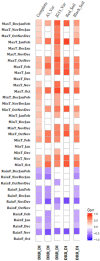Low soil moisture predisposes field-grown chickpea plants to dry root rot disease: evidence from simulation modeling and correlation analysis
- PMID: 33753791
- PMCID: PMC7985499
- DOI: 10.1038/s41598-021-85928-6
Low soil moisture predisposes field-grown chickpea plants to dry root rot disease: evidence from simulation modeling and correlation analysis
Abstract
Rhizoctonia bataticola causes dry root rot (DRR), a devastating disease in chickpea (Cicer arietinum). DRR incidence increases under water deficit stress and high temperature. However, the roles of other edaphic and environmental factors remain unclear. Here, we performed an artificial neural network (ANN)-based prediction of DRR incidence considering DRR incidence data from previous reports and weather factors. ANN-based prediction using the backpropagation algorithm showed that the combination of total rainfall from November to January of the chickpea-growing season and average maximum temperature of the months October and November is crucial in determining DRR occurrence in chickpea fields. The prediction accuracy of DRR incidence was 84.6% with the validation dataset. Field trials at seven different locations in India with combination of low soil moisture and pathogen stress treatments confirmed the impact of low soil moisture on DRR incidence under different agroclimatic zones and helped in determining the correlation of soil factors with DRR incidence. Soil phosphorus, potassium, organic carbon, and clay content were positively correlated with DRR incidence, while soil silt content was negatively correlated. Our results establish the role of edaphic and other weather factors in chickpea DRR disease incidence. Our ANN-based model will allow the location-specific prediction of DRR incidence, enabling efficient decision-making in chickpea cultivation to minimize yield loss.
Conflict of interest statement
The authors declare no competing interests.
Figures





References
Publication types
MeSH terms
Substances
LinkOut - more resources
Full Text Sources
Other Literature Sources

